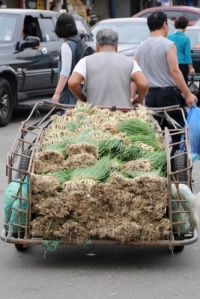” i eumsik maewoyo?” meaning “Is this dish spicy?” was a Korean phrase I quickly learned. Much Korean food is prepared with hot, and I mean HOT, red pepper sauce. (Scores of peppers are laid out on sidewalks or hung to dry in preparation for this.) Of course, spicy is relative. I learned that, even if I was told “no”, the food was likely at least somewhat spicy, so I’d just order “no spice.” That meant it would be just right for me. When it wasn’t, I’d just order extra rice to absorb the hot spicy food. Jim had a higher tolerance for the hot spice, so it was not as much of a problem for him.
In traditional Korean restaurants you remove your shoes upon entering. However, the floors are almost always gleaming, so no worries about dirty feet. Seating is on the floor, on a mat if you wish. It’s awkward at first, but you get used to it.
Just to make sure you’re hands are clean, you are given a facecloth or paper towel. Long chopsticks and a long-handled spoon are either brought to the table, or available in a nearby box or drawer. The long handles help in reaching and eating from the pots or bowls in the middle of the table.
Dining out is a very social, communal event with everyone eating from a common bowl. For many, including Jeremy and his friends, it is easier and cheaper than cooking at home. Single diners are not common as most dishes are prepared for two or more. (The guide book mentioned this, and warned that you could wind up paying for a dish for two even if you are eating alone. Fortunately it was always at least the two of us, sometimes more sharing the food.)
At the Meet the Parents night, we chose a TGIFridays restaurant, which greatly pleased Jeremy’s friends, all who teach English in Incheon or Seoul, and occasionally get homesick for “western” food. “Sometimes you just want a burger,” said Mason (foreground left. Clockwise from Mason, Justin, Jim, Christia, Alexandra, me, Jeremy, and Jeff (Ferg).)
With its vegetables—especially green onions— colourful blends of seasonings and spices, and various types of noodles—hot and cold, soft and crunchy—the colours, tastes, and textures of Korean food are notable. Rice and noodle dishes are prevalent and usually served with vegetables and meat or any and all kinds of seafood imaginable, sometimes raw, but often grilled, braised or fried.
Whether we were on a wide modern thoroughfare, or an older very narrow street, there was no shortage of restaurants; mostly Korean, but also some Japanese, Chinese, and western establishments. McDonald’s, Outback, and TGIFridays were common sights, especially in the cities.
I wondered aloud how they could all stay in business, and Jeremy answered, “the density of the population” There are approximately 25 million people in the greater Seoul area and about 70 percent of South Korea’s population of 49 million lives within its seven major cities, according to the guide book.
No matter what we were in the mood to eat, we’d find it. Thankfully, most of the restaurants had menus with pictures so we could see what was available, and not have to rely on our limited knowledge of the language to order. We were happy when Jeremy could join us, not only to enjoy his company, but for his familiarity with placing orders (calling Yo Yo to the servers, for example, and knowing the phrasing.)
Small side dishes of various types of kimchi are brought to share. There are lots of varieties of kimchi, for example, using radish, cucumber, eggplant or leeks, usually fermented with the aforementioned hot peppers. Most commonly, kimchi is made with cabbage. (By the end of our visit, there was news of damage to cabbage crops due to a recent typhoon. As a result cabbage prices had risen dramatically leading to a kimchi shortage. Instead of it being served routinely, it was now only available upon request.)
Depending on your order, there may also be dishes of sesame leaves or seaweed, and another type of salad, and a hot or cold broth. Small bowls of steamed rice are usually served and meat or seafood is often cooked at the table. Everything is within reach.
Except perhaps in the “western” restaurants there are no “mega meals” or “super-sized” portions here. One report stated that health officials are concerned that obesity rates have risen to four percent of the population this year in Korea. Makes you cringe when you think about reports of 25-30 percent of our population considered overweight or obese.
In spite of the sometimes too-spicy-for me food, we enjoyed this new, traditional way of eating. We’ve already had a dinner party where I served bibimbap. I plan to make gimbap and other Korean dishes from recipes in a cookbook I bought in Seoul. I’ll go easy on the red peppers though, so no one will have to ask, “i eumsik maewoyo?”
Anglicized pronunciation for “i eumsik maewoyo”:
ee oom shik ma waw yo






